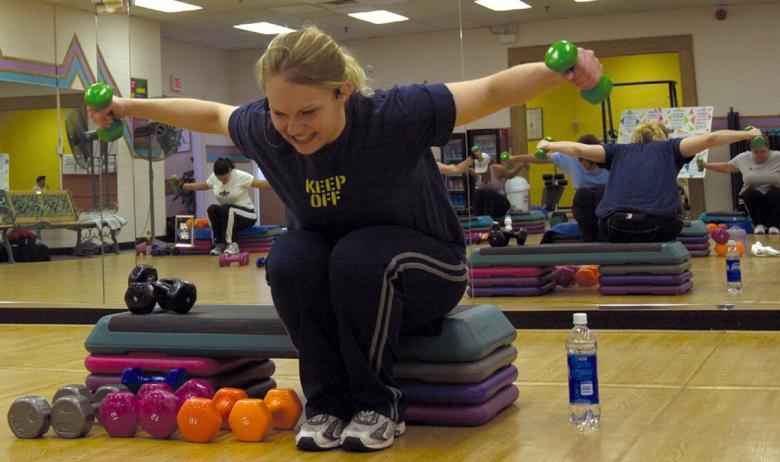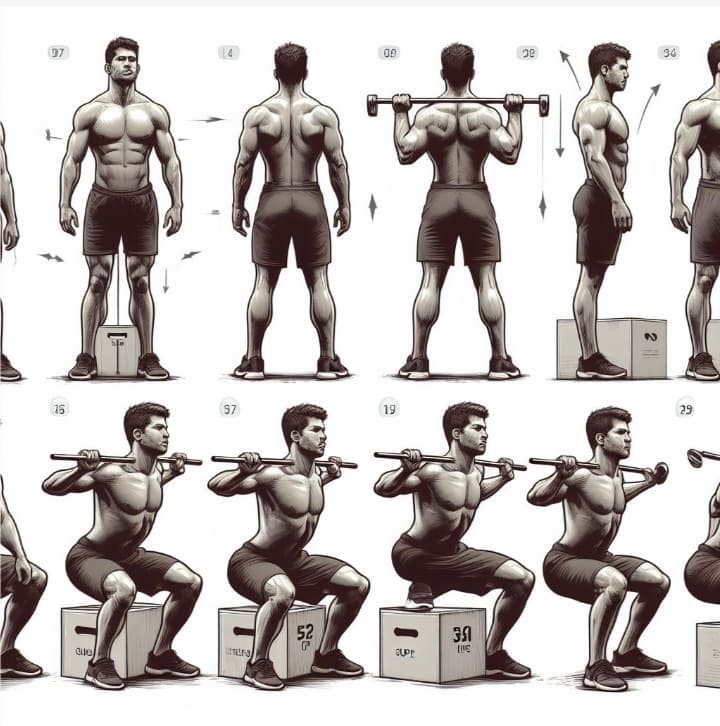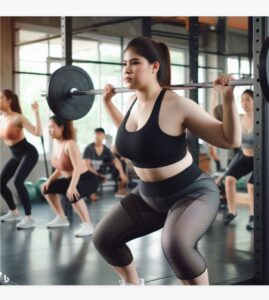
Box squats are a popular variation of the traditional squat exercise that involves sitting back onto a box or bench before standing back up. This exercise are a versatile and effective exercise that can greatly benefit individuals of all fitness levels.
By incorporating box squats into your training routine, you can experience a wide range of powerful benefits. In this article, we will explore the nine key benefits of box squats and explain how they provide each of these advantages.
Before we dive into these powerful nine benefits of box squats, let’s talk about the mechanism and techniques of this advantageous exercise.
What are box squats?
Box squats are a type of squat that is performed using a box or bench. The box provides a target depth for the squat, which can help to improve form and prevent overtraining. Box squats are also a great way to increase strength and power in the lower body.
Muscles worked
Box squats work all of the major muscle groups in the lower body, including the quadriceps, hamstrings, glutes, and calves. They also work the core muscles and the upper back muscles.
How to do box squats with proper form
To perform box squats with proper form, follow these steps:
- Set up a box or bench at the desired height. The height of the box should allow your thighs to be parallel to the ground when you are seated.
- Stand in front of the box with your feet shoulder-width apart and your toes pointed slightly outward.
- Bend down at the hips and lower your body down until your butt touches the box.
- Keep your back straight and your core engaged throughout the movement.
- Pause for a second at the bottom of the squat.
- Drive through your heels to stand back up.
- Exhale as you stand up.
- Repeat for the desired number of repetitions.
Variations
Here are some variations of box squats that you can try:
- Narrow stance box squats: This variation places more emphasis on the quadriceps muscles.
- Wide stance box squats: This variation places more emphasis on the glute muscles.
- Box squat with a pause: This variation increases the difficulty of the exercise by making you pause for a second at the bottom of the squat.
- Box squat with a band: This variation adds resistance to the exercise, making it more challenging.
If you are unable to perform box squats with proper form, there are a few modifications you can make:
- Use a higher box: This will allow you to lower your body down without feeling as much strain on your lower back.
- Use a band for assistance: The band will help you to stand back up from the squat.
- Do bodyweight squats: This is a great way to start if you are new to squatting.
As you get stronger, you can gradually increase the weight you use or the number of repetitions you perform. You can also try using a lower box to challenge yourself further.
Benefits of Box Squats

Box squats, an often overlooked exercise in the realm of strength training, harbor a wealth of unique advantages that can significantly amplify lower body strength and overall fitness. Here are nine key benefits of performing box squats:
1. Improved Squat Technique
One of the primary benefits of box squats is that they help improve squat technique. By performing squats onto a box, individuals are forced to maintain proper form and control throughout the movement. This helps in developing proper squat mechanics, including maintaining a neutral spine, engaging the core, and achieving proper depth. Over time, this improved technique can lead to increased strength and reduced risk of injury.
2. Increased Lower Body Strength
Box squats target the muscles of the lower body, including the quadriceps, hamstrings, glutes, and calves. By performing this exercise regularly, individuals can increase their lower body strength significantly. The pause on the box during the squat also increases the demand on the muscles, making them work harder to stand back up. This increased muscular demand leads to greater strength gains over time.
They target the posterior chain muscles, including the hamstrings and glutes thereby Strengthening the Hamstrings and Glutes
3. Enhanced Explosiveness
Box squats are a fantastic exercise for developing explosiveness and power. When performing box squats, individuals have to generate force from a paused position, which requires a higher amount of power output when standing back up. This explosive movement helps in sports that require quick and powerful movements, such as sprinting, jumping, and weightlifting.
4. Improved Hip Mobility
Squatting onto a box requires individuals to sit back and engage their hips, which helps improve hip mobility. This exercise helps in increasing hip flexion and extension, which is crucial for maintaining proper squat depth and performing various other lower body movements effectively. Improved hip mobility can also alleviate hip pain and improve overall movement quality.
5. Increased Stability and Balance
Box squats require individuals to maintain balance and stability throughout the movement. The act of sitting back onto the box and standing back up challenges the core muscles and enhances stability in the hips, knees, and ankles. This improved stability and balance carry over to other exercises and daily activities, reducing the risk of falls and injuries.
6. Injury Prevention
By focusing on form and technique, box squats can help prevent injuries. The controlled movement and emphasis on proper alignment reduce the risk of straining or overloading the joints and muscles. Additionally, box squats can be modified to accommodate individuals with specific limitations or injuries, making them a safer alternative to traditional squats.
7. Increased Range of Motion
Performing box squats can help individuals increase their range of motion over time. By gradually lowering the height of the box, individuals can work towards achieving a deeper squat position. This increased range of motion not only improves squat performance but also translates to better mobility and flexibility in everyday activities.
8. Specificity to Sport
Box squats offer sport-specific benefits to athletes. The pause at the bottom of the squat mimics the isometric hold often required in sports, such as football, basketball, and martial arts. By incorporating box squats into their training routine, athletes can enhance their ability to generate power and explosiveness from a static position, which can improve performance in their respective sports.
9. Versatility and Adaptability
Box squats can be modified to suit individual needs and goals. The height of the box can be adjusted based on an individual’s mobility and strength level. Additionally, the exercise can be performed using various equipment such as dumbbells, barbells, or kettlebells, allowing for progressive overload and targeting different muscle groups.
Box squats offer numerous powerful benefits, including improved squat technique, increased lower body strength, enhanced explosiveness, improved hip mobility, increased stability and balance, injury prevention, increased range of motion, sport-specificity, and versatility. Incorporating box squats into a well-rounded training program can help individuals of all fitness levels reach their goals and improve overall physical performance.
Box squats can be a safer alternative to traditional squats for those with knee pain or injuries. By selecting a higher box, you can reduce the force on your joints and can help boost body awareness, rehab nagging injuries, and correct wonky squat form. They can also give you the edge you need to push past squat plateaus and crush your personal records, When done correctly and regularly, box squats can improve muscle flexibility and range of motion, enabling you to squat deeper over time. This is important not only for working out but also for everyday life, as squatting is a functional movement that we do often

How to Maximize Box Squats benefits
To maximize the benefits of box squats, follow these tips:
1. Use the right box height: The height of the box should allow your thighs to be parallel to the ground when you are seated. If the box is too high, you will not be able to squat down as far as you should. If the box is too low, you will be putting too much stress on your lower back.
2. Use proper form: Keep your back straight, your core engaged, and your heels flat on the ground throughout the entire movement.
3. Focus on quality over quantity: It is better to do a few repetitions with perfect form than to do many repetitions with poor form.
4. Breathe properly: Exhale as you stand up from the squat and inhale as you lower yourself down.
5. Warm up before you start squatting and cool down afterwards.
6. Use a weight that is challenging but allows you to maintain good form.
7. Gradually increase the weight and/or the number of repetitions you perform as you get stronger.
8. Listen to your body and take rest days when needed.
9. Incorporate box squats into your regular workout routine. Aim to perform box squats 2-3 times per week.
10. Gradual Progression: Start with a box or bench height that allows you to maintain proper form. Gradually lower the box height to increase depth and difficulty. As your strength and flexibility improve, challenge yourself by reducing the box height, incrementally progressing to lower positions.
11. Controlled Movement: Concentrate on controlled movements during the descent and ascent. Avoid using excessive momentum or bouncing off the box, ensuring each repetition is deliberate and controlled for optimal muscle engagement.
Here are some additional tips for maximizing the benefits of box squats:
- Pause at the bottom of the squat for a second or two. This will help you to build more strength and muscle.
- Use a band around your thighs for added resistance. This will help you to activate more muscle fibers.
- Vary the width of your stance. A wider stance will place more emphasis on your glutes, while a narrower stance will place more emphasis on your quadriceps.
- Try different types of box squats, such as bodyweight box squats, barbell box squats, and dumbbell box squats.
By following these tips optimizes the benefits of box squats, leading to enhanced lower body strength, muscle development, and overall fitness gains. Always focus on proper form and progression, and seek guidance from fitness professionals if needed.
Related Posts
Reference:
https://blog.thewodlife.com.au/benefits-box-squats/
https://sunnyhealthfitness.com/blogs/health-wellness/box-squats-benefits-and-how-to
https://www.shape.com/fitness/workouts/box-squats
https://breakingmuscle.com/5-reasons-you-should-box-squat/
https://www.healthline.com/health/box-squats
https://barbend.com/box-squat/





















